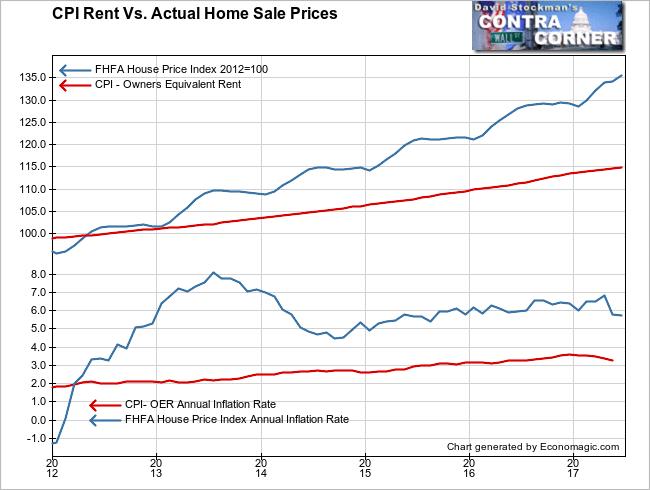“U.S. Consumer Prices Unchanged in June!” trumpeted the Wall Street Journal, with similar headlines coming from the rest of the media.
Yes, we have no inflation! That’s the mantra we keep hearing, and it was reinforced by the CPI release for June. Whenever I see these headlines it reminds me of the old Ragtime song, Yes, We Have No Bananas, sung by Al Jolson. We got everything else, but we have no inflation today.
And yes, we have little inflation in some consumption goods, at least in that arbitrary basket of goods measured by the CPI. And even less in the Fed’s favorite measure of “inflation,” the core PCE. But neither measure includes housing prices, let alone asset prices generally, and financial assets in particular. Inflation is raging in those. The latest figure on housing inflation shows that it’s running in the 6-7% range. It’s not included in either the Fed’s or the media’s favorite, peculiar, price indexes.
Not only does the PCE not include housing prices, it even goes so far as to reduce the weighting of the items in its basket that are increasing fastest in price, and increases the weighting of items increasing more slowly. Tell me, dear readers, how is that a consistent measure of inflation.
Supposedly, according to the standard, historical, textbook, definition of inflation, it is a “rise in the general level of prices.” Notice it isn’t limited to the prices of consumer goods. The general level of prices would include wholesale goods. It would include services of all kinds, not just to consumers. And it would include assets.
But as narrowly seen by the Fed, the government, and especially by economists and the media, it is limited only to the prices of some, but not all, goods and services supplied to consumers.
The exclusion of housing prices is particularly egregious because it was and is deliberate. Housing prices were removed from the CPI in 1982 because rapidly inflating home prices were causing a tremendous increase in the cost of government benefits, and particularly in the costs of labor contracts to industry.
Contracts negotiated between businesses and unions virtually always included a wage escalator tied to CPI. Driven largely by rapidly inflating home price, the CPI had risen to double digits. Business had a friend in the White House at the time who was particularly antithetical to organized labor. The Administration slammed through a change in the method of calculating CPI that removed housing costs and substituted an imaginary measure called Owner’s Equivalent Rent (OER). That measure has suppressed CPI for the last 35 years. This has saved government and business hundreds of billions of dollars in costs that would have gone to workers and government beneficiaries.
Over the past 5 years, since the Fed first formally announced its 2% target for the Core PCE rate of increase, OER has had the impact of cumulatively understating housing inflation by 20%. The current rate of OER is now 3.2%. But home prices are rising at a rate of 5.8%. So when you read the headlines that the CPI was flat for June, bear in mind that this only includes housing inflation at half its actual rate. That housing figure accounts for 31% of the headline CPI and 41% of Core CPI.

While headline CPI was reported to be flat based on the usual seasonal adjustment hocus pocus, Core CPI rose by 0.1%. The Journal reported that, “From a year earlier, consumer prices climbed only 1.6%, marking the fourth straight month annual gains have eased. Prices were up 1.7% on the year when excluding food and energy.” The year to year change figures were accurate based on the not seasonally adjusted data.
However, adjusted for housing costs, using the actual inflation rate of house prices instead of OER, the annual inflation rate of the Core CPI would have been approximately +2.5%, not +1.7%.
Even that rate is doubtful, based on possible skewing in the CPI basket before including housing. A measure I like to use as a check is the Producer Price Index for Finished Consumer Goods. In other words these are the costs of the goods you buy in retail stores like Walmart, Kroger, Costco, and Amazon.com. It is reasonable to assume that retailers pass along their increased costs in the retail price of the products you buy. In fact, it the absence of an outright recession and massive inventory buildup, it would be unreasonable to assume that they don’t pass along their costs. We see it either in rising prices, or size reductions.
The BLS uses hedonics to suppress those increases in the CPI. That doesn’t happen with the PPI. The BLS assumes in the CPI, that you the consumer will substitute lower cost hamburger for steak when the price of steak rises. I guess that when the price of hamburger rises, they assume that you switch to dogfood with a similar mix of protein.
OK, I jest, but if the goods in the basket being measured are not consistent, then CPI isn’t a consistent measure of consumer goods inflation. The PPI for finished consumer goods does not suffer from that kind of manipulation. That measure is currently rising at an annual rate of 2.5%. Except for a few months in 2013, that measure has never been materially below 2% during the entire 5 1/2 years since the Fed officially announced its 2% inflation target.

When we look closely at the data, we see the fudging and obfuscation in the CPI. Yes, there is inflation. Inflation is NOT below 2%. If it were correctly measured, it would show that it’s running at 2.5% if we include housing, and if we don’t finagle our basket of consumer goods. That’s also supported by the current 2.5% growth rate in wages, which have been rising at an accelerating rate over the past year. We’ll look at that in a post later this week.


